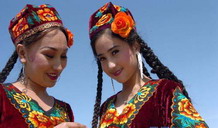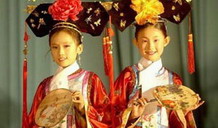History of the Mongolian Ethnic Group
Mongolian history stretches back more than 2,000 years. In 1991, Mongolians celebrated the anniversary of the establishment of the first Hun State in 209 B.C.
Mongolian archaeologists have discovered 500,000 year-old stone implements that are the remains of Mongolia's earliest inhabitants. Since the early primitive communal era, Mongols lived independently in the neighborhood of such nomadic tribes as the Turks and Khamnigan.
In 209 B.C., the Huns, who originated from ancient nomadic tribes such as Xianyu, Xianyung, Hun yi and Di, set up the first state in Central Asia. The Hun state was equal in power to the Chinese states of Qin (206 B.C.-24 A.D.) and Han (206 B.C.-220 A.D.). The sovereign of the state of Han Wendi wrote to Shan Yu of the Hun State: "in accordance with the decree of his Majesty, the state situated to the north of the Great Wall shall be governed by the decrees of Shan Yu, and the territory situated to the south of the Great Wall, peopled by those who wear tushmed belts and caps, shall be governed by me. Both the state of the Huns and the state of Han are powerful neighbor states."
The territory of the Huns was vast and extended to the Great Wall in the south, Lake Baikal in the north, the Hingan Mountains in the east, and the Erchis River in the west. The state maintained wide diplomatic, cultural and trade relations with neighboring countries. In the middle of the first century A.D. the Hun state split into north and south. The southern Huns established the Han and Xi states within the Great Wall, which existed until the 10th century, while the northern Huns migrated to East Europe and settled down there by the 4th-5th centuries A.D.
Between the 3rd-6thcenturies the territory of the Hun state was occupied successively by the states of Xianbi and Jhou Jhan, and Chinese historians noted the power of these states was equal to that of the Huns.
During the 7th-l0th centuries, the present Mongolian territory was inhabited by the Turkic, Uighur and Kirghiz tribes. But there is little information about the life of the Mongols at this period.
During the 9th-10th centuries, the Kidans, who were a Mongolian-speaking tribe, established the Great Liao State in north China.
During the 11th-12th centuries, the Mongol tribes were known as Whole Mongolia, Tatar, Kerait, and Jalair. These neighboring tribes had their own rulers and were constantly fighting with each other. At this time of intertribal struggle, a Mongol chieftain called Tie Muzhen (Temudjin) gathered various tribes under his leadership, named his state "Mongolia," and renamed himself "Genghis Khan." The difficult process of establishing the Mongolian state was finely described in the famous Mongolian document "Nuuts Tovchoo" ("Secret History of the Mongols").






